The Cambridge History of Japan, Vol. 3: Medieval Japan
Подождите немного. Документ загружается.

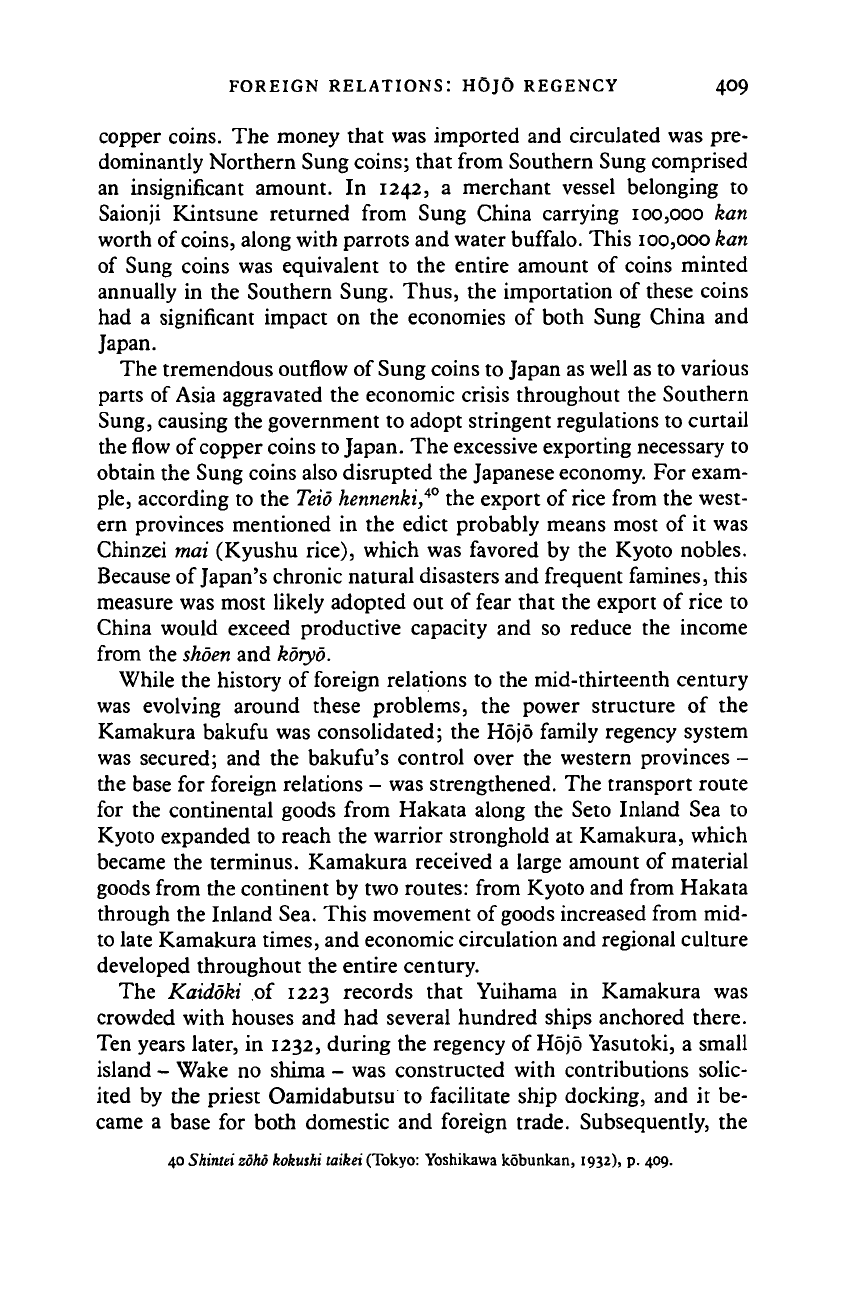
FOREIGN RELATIONS: HOJO REGENCY 409
copper coins. The money that was imported and circulated was pre-
dominantly Northern Sung coins; that from Southern Sung comprised
an insignificant amount. In 1242, a merchant vessel belonging to
Saionji Kintsune returned from Sung China carrying 100,000 kan
worth of
coins,
along with parrots and water buffalo. This 100,000 kan
of Sung coins was equivalent to the entire amount of coins minted
annually in the Southern Sung. Thus, the importation of these coins
had a significant impact on the economies of both Sung China and
Japan.
The tremendous outflow of Sung coins to Japan as well as to various
parts of Asia aggravated the economic crisis throughout the Southern
Sung, causing the government to adopt stringent regulations to curtail
the
flow
of copper coins to Japan. The excessive exporting necessary to
obtain the Sung coins also disrupted the Japanese economy. For exam-
ple,
according to the
Teid
kennenki,
40
the export of rice from the west-
ern provinces mentioned in the edict probably means most of it was
Chinzei mai (Kyushu rice), which was favored by the Kyoto nobles.
Because of Japan's chronic natural disasters and frequent famines, this
measure was most likely adopted out of fear that the export of rice to
China would exceed productive capacity and so reduce the income
from the shoen and koryo.
While the history of foreign relations to the mid-thirteenth century
was evolving around these problems, the power structure of the
Kamakura bakufu was consolidated; the Ho jo family regency system
was secured; and the bakufu's control over the western provinces -
the base for foreign relations - was strengthened. The transport route
for the continental goods from Hakata along the Seto Inland Sea to
Kyoto expanded to reach the warrior stronghold at Kamakura, which
became the terminus. Kamakura received a large amount of material
goods from the continent by two routes: from Kyoto and from Hakata
through the Inland Sea. This movement of
goods
increased from mid-
to late Kamakura times, and economic circulation and regional culture
developed throughout the entire century.
The Kaidoki of 1223 records that Yuihama in Kamakura was
crowded with houses and had several hundred ships anchored there.
Ten years later, in 1232, during the regency of Hojo Yasutoki, a small
island - Wake no shima - was constructed with contributions solic-
ited by the priest Oamidabutsu to facilitate ship docking, and it be-
came a base for both domestic and foreign trade. Subsequently, the
40 Shinlei zoho kokushi taikei (Tokyo: Yoshikawa kobunkan, 1932), p. 409.
Cambridge Histories Online © Cambridge University Press, 2008
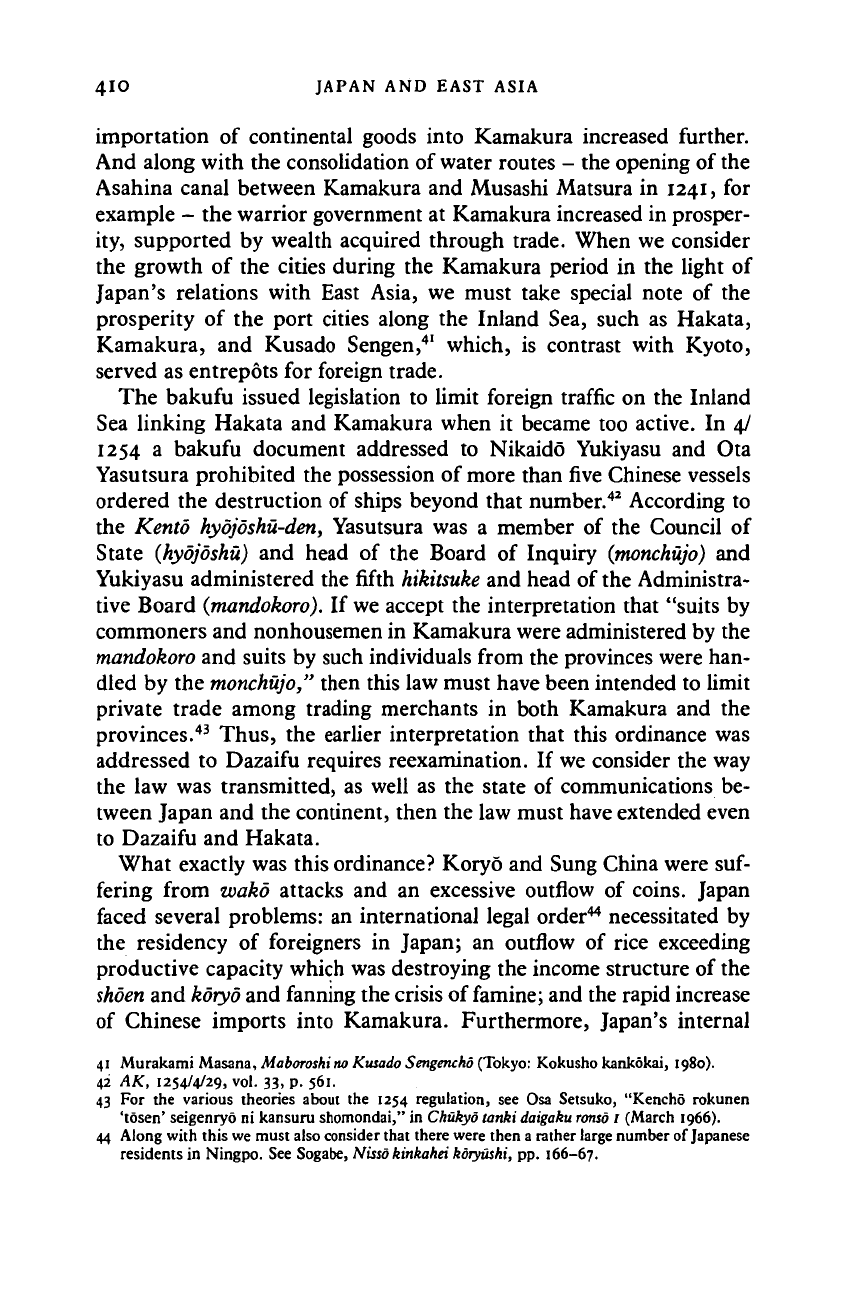
4IO JAPAN AND EAST ASIA
importation of continental goods into Kamakura increased further.
And along with the consolidation of water routes - the opening of the
Asahina canal between Kamakura and Musashi Matsura in 1241, for
example - the warrior government at Kamakura increased in prosper-
ity, supported by wealth acquired through trade. When we consider
the growth of the cities during the Kamakura period in the light of
Japan's relations with East Asia, we must take special note of the
prosperity of the port cities along the Inland Sea, such as Hakata,
Kamakura, and Kusado Sengen,
41
which, is contrast with Kyoto,
served as entrepots for foreign trade.
The bakufu issued legislation to limit foreign traffic on the Inland
Sea linking Hakata and Kamakura when it became too active. In 4/
1254 a bakufu document addressed to Nikaido Yukiyasu and Ota
Yasutsura prohibited the possession of more than five Chinese vessels
ordered the destruction of ships beyond that number.
42
According to
the Kento
hybjoshu-den,
Yasutsura was a member of the Council of
State
{hydjoshu)
and head of the Board of Inquiry
{monchujo)
and
Yukiyasu administered the fifth
hikitsuke
and head of the Administra-
tive Board
{mandokoro).
If we accept the interpretation that "suits by
commoners and nonhousemen in Kamakura were administered by the
mandokoro
and suits by such individuals from the provinces were han-
dled by the
monchujo,"
then this law must have been intended to limit
private trade among trading merchants in both Kamakura and the
provinces.
43
Thus, the earlier interpretation that this ordinance was
addressed to Dazaifu requires reexamination. If we consider the way
the law was transmitted, as well as the state of communications be-
tween Japan and the continent, then the law must have extended even
to Dazaifu and Hakata.
What exactly was this ordinance? Koryo and Sung China were suf-
fering from wako attacks and an excessive outflow of coins. Japan
faced several problems: an international legal order
44
necessitated by
the residency of foreigners in Japan; an outflow of rice exceeding
productive capacity which was destroying the income structure of the
shoen
and
koryo
and fanning the crisis of famine; and the rapid increase
of Chinese imports into Kamakura. Furthermore, Japan's internal
41 Murakami Masana,
Maboroshi no
Kusado
Sengencko
(Tokyo: Kokusho kankokai, 1980).
42 AK, 1254/4/29, vol. 33, p. 561.
43 For the various theories about the 1254 regulation, see Osa Setsuko, "Kencho rokunen
'tosen' seigenryo ni kansuru shomondai," in Chukyo tanki
daigaku ronso
1 (March 1966).
44 Along with this we must also consider that there were then a rather large number of Japanese
residents in Ningpo. See Sogabe, Nisso kinkahei kmyushi, pp. 166-67.
Cambridge Histories Online © Cambridge University Press, 2008
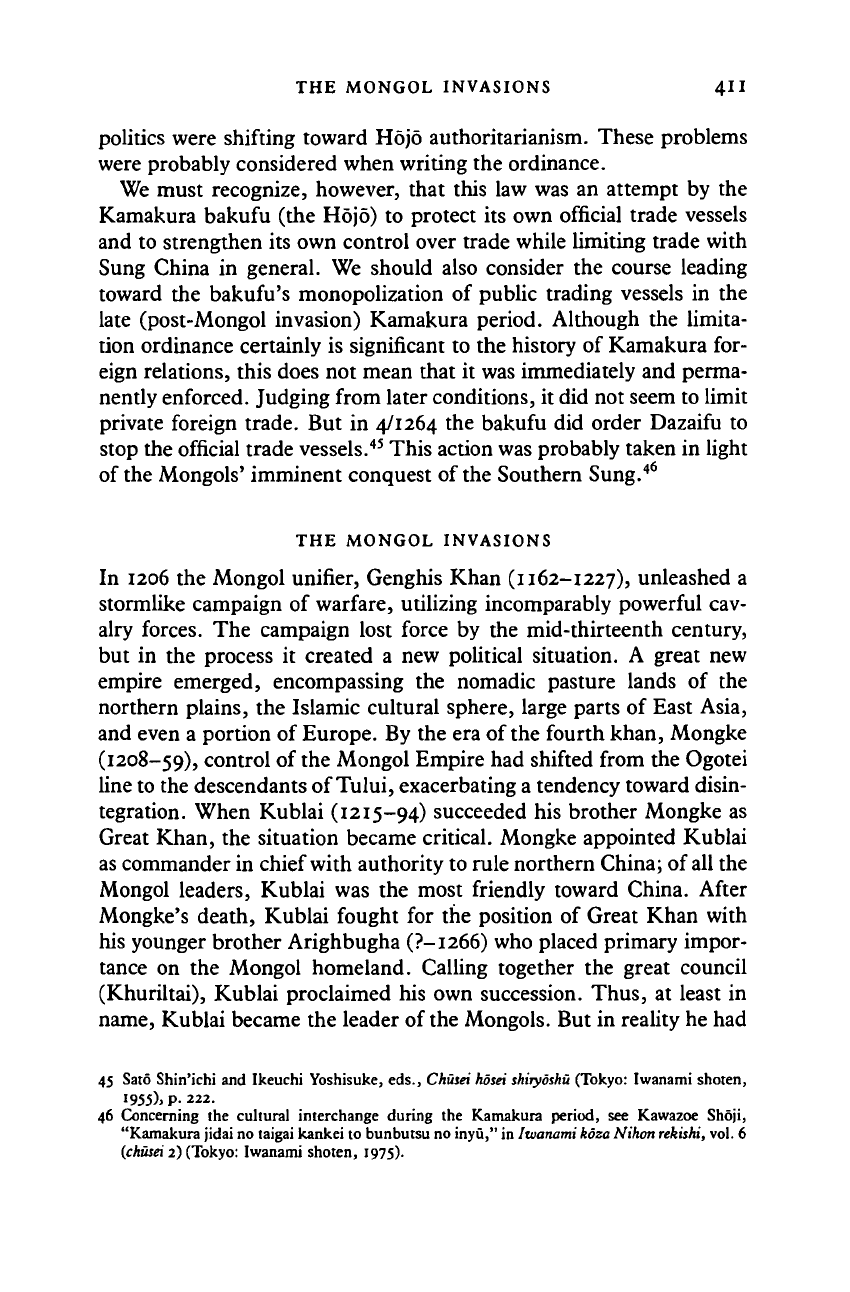
THE MONGOL INVASIONS 411
politics were shifting toward Hojo authoritarianism. These problems
were probably considered when writing the ordinance.
We must recognize, however, that this law was an attempt by the
Kamakura bakufu (the Hojo) to protect its own official trade vessels
and to strengthen its own control over trade while limiting trade with
Sung China in general. We should also consider the course leading
toward the bakufu's monopolization of public trading vessels in the
late (post-Mongol invasion) Kamakura period. Although the limita-
tion ordinance certainly is significant to the history of Kamakura for-
eign relations, this does not mean that it was immediately and perma-
nently enforced. Judging from later conditions, it did not seem to limit
private foreign trade. But in 4/1264 the bakufu did order Dazaifu to
stop the official trade vessels.
45
This action was probably taken in light
of the Mongols' imminent conquest of the Southern Sung.
46
THE MONGOL INVASIONS
In 1206 the Mongol unifier, Genghis Khan (1162-1227), unleashed a
stormlike campaign of warfare, utilizing incomparably powerful cav-
alry forces. The campaign lost force by the mid-thirteenth century,
but in the process it created a new political situation. A great new
empire emerged, encompassing the nomadic pasture lands of the
northern plains, the Islamic cultural sphere, large parts of East Asia,
and even a portion of Europe. By the era of the fourth khan, Mongke
(1208-59), control of the Mongol Empire had shifted from the Ogotei
line to the descendants of Tului, exacerbating
a
tendency toward disin-
tegration. When Kublai (1215-94) succeeded his brother Mongke as
Great Khan, the situation became critical. Mongke appointed Kublai
as commander in chief with authority to rule northern China; of all the
Mongol leaders, Kublai was the most friendly toward China. After
Mongke's death, Kublai fought for the position of Great Khan with
his younger brother Arighbugha (P-I266) who placed primary impor-
tance on the Mongol homeland. Calling together the great council
(Khuriltai), Kublai proclaimed his own succession. Thus, at least in
name, Kublai became the leader of
the
Mongols. But in reality he had
45 Sato Shin'ichi and Ikeuchi Yoshisuke, eds., Chusei hosei
shiryoshu
(Tokyo: Iwanami shoten,
1955).
P- 222.
46 Concerning the cultural interchange during the Kamakura period, see Kawazoe Shoji,
"Kamakura jidai no taigai kankei to bunbutsu no inyu," in Iwanami koza Nihon rekishi, vol. 6
(chusei
2) (Tokyo: Iwanami shoten, 1975).
Cambridge Histories Online © Cambridge University Press, 2008
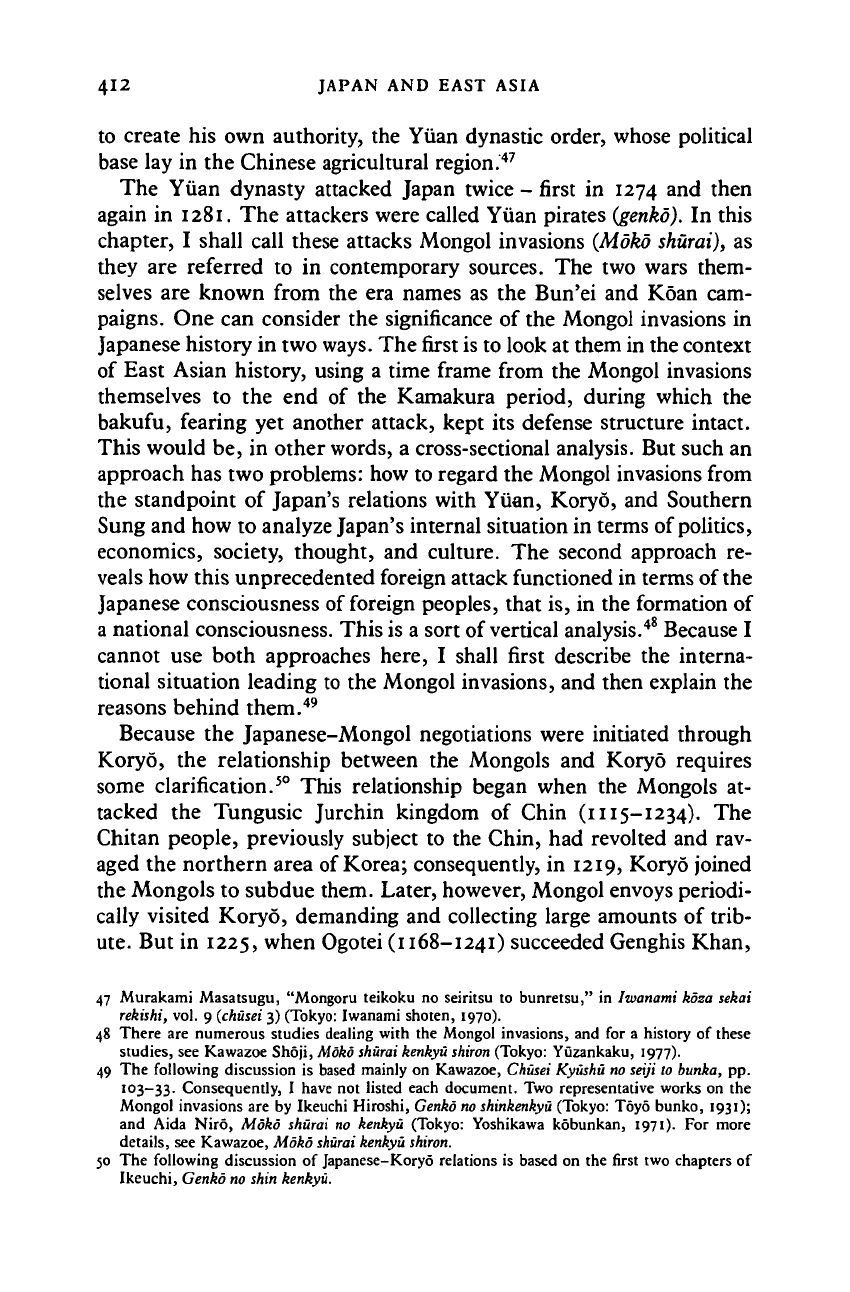
412 JAPAN AND EAST ASIA
to create his own authority, the Yuan dynastic order, whose political
base lay in the Chinese agricultural region.
47
The Yuan dynasty attacked Japan twice - first in 1274 and then
again in 1281. The attackers were called Yuan pirates
{genko).
In this
chapter, I shall call these attacks Mongol invasions
{Moko
shurai),
as
they are referred to in contemporary sources. The two wars them-
selves are known from the era names as the Bun'ei and Koan cam-
paigns. One can consider the significance of the Mongol invasions in
Japanese history in two
ways.
The first is to look at them in the context
of East Asian history, using a time frame from the Mongol invasions
themselves to the end of the Kamakura period, during which the
bakufu, fearing yet another attack, kept its defense structure intact.
This would be, in other words, a cross-sectional analysis. But such an
approach has two problems: how to regard the Mongol invasions from
the standpoint of Japan's relations with Yuan, Koryo, and Southern
Sung and how to analyze Japan's internal situation in terms of politics,
economics, society, thought, and culture. The second approach re-
veals how this unprecedented foreign attack functioned in terms of the
Japanese consciousness of foreign peoples, that is, in the formation of
a national consciousness. This is a sort of vertical analysis.
48
Because I
cannot use both approaches here, I shall first describe the interna-
tional situation leading to the Mongol invasions, and then explain the
reasons behind them.
49
Because the Japanese-Mongol negotiations were initiated through
Koryo, the relationship between the Mongols and Koryo requires
some clarification.
50
This relationship began when the Mongols at-
tacked the Tungusic Jurchin kingdom of Chin (1115-1234). The
Chitan people, previously subject to the Chin, had revolted and rav-
aged the northern area of Korea; consequently, in 1219, Koryo joined
the Mongols to subdue them. Later, however, Mongol envoys periodi-
cally visited Koryo, demanding and collecting large amounts of trib-
ute.
But in 1225, when Ogotei (1168-1241) succeeded Genghis Khan,
47 Murakami Masatsugu, "Mongoru teikoku no seiritsu to bunretsu," in Iwanami koza sekai
rekishi, vol. 9 (chusei 3) (Tokyo: Iwanami shoten, 1970).
48 There are numerous studies dealing with the Mongol invasions, and for a history of these
studies, see Kawazoe Shoji, Moko shurai kenkyu
shiron
(Tokyo: Yuzankaku, 1977).
49 The following discussion is based mainly on Kawazoe, Chusei Kyushu no seiji to bunka, pp.
103—33.
Consequently, I have not listed each document. Two representative works on the
Mongol invasions are by Ikeuchi Hiroshi, Genko noshinkenkyu (Tokyo: Toyo bunko, 1931);
and Aida Niro, Moko shurai no kenkyu (Tokyo: Yoshikawa kobunkan, 1971). For more
details, see Kawazoe, Moko
shurai
kenkyu shiron.
50 The following discussion of Japanese-Koryo relations is based on the first two chapters of
Ikeuchi, Genko no shin kenkyu.
Cambridge Histories Online © Cambridge University Press, 2008
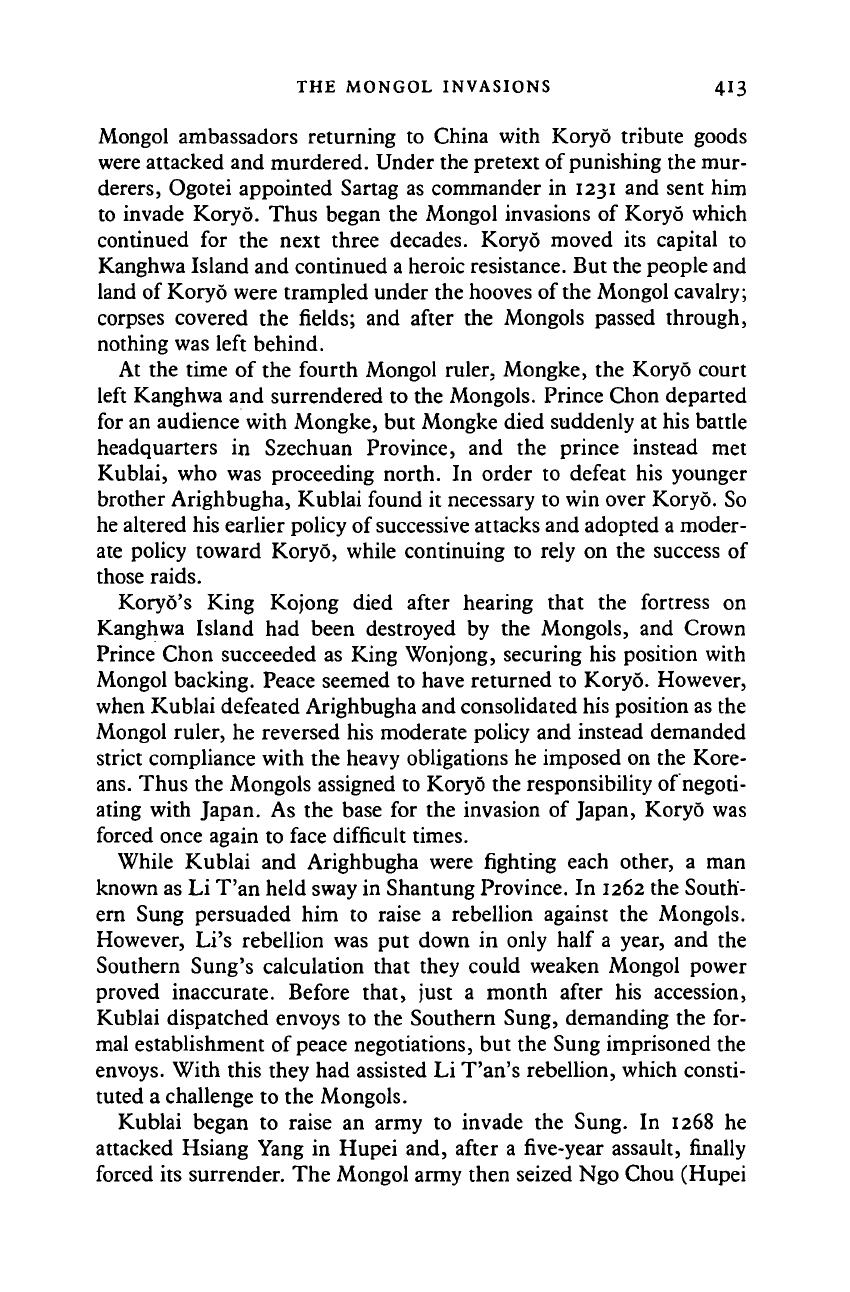
THE MONGOL INVASIONS 413
Mongol ambassadors returning to China with Koryo tribute goods
were attacked and murdered. Under the pretext of punishing the mur-
derers, Ogotei appointed Sartag as commander in 1231 and sent him
to invade Koryo. Thus began the Mongol invasions of Koryo which
continued for the next three decades. Koryo moved its capital to
Kanghwa Island and continued a heroic resistance. But the people and
land of Koryo were trampled under the hooves of the Mongol cavalry;
corpses covered the fields; and after the Mongols passed through,
nothing was left behind.
At the time of the fourth Mongol ruler, Mongke, the Koryo court
left Kanghwa and surrendered to the Mongols. Prince Chon departed
for an audience with Mongke, but Mongke died suddenly at his battle
headquarters in Szechuan Province, and the prince instead met
Kublai, who was proceeding north. In order to defeat his younger
brother Arighbugha, Kublai found it necessary to win over Koryo. So
he altered his earlier policy of successive attacks and adopted a moder-
ate policy toward Koryo, while continuing to rely on the success of
those raids.
Koryo's King Kojong died after hearing that the fortress on
Kanghwa Island had been destroyed by the Mongols, and Crown
Prince Chon succeeded as King Wonjong, securing his position with
Mongol backing. Peace seemed to have returned to Koryo. However,
when Kublai defeated Arighbugha and consolidated his position as the
Mongol ruler, he reversed his moderate policy and instead demanded
strict compliance with the heavy obligations he imposed on the Kore-
ans.
Thus the Mongols assigned to Koryo the responsibility of negoti-
ating with Japan. As the base for the invasion of Japan, Koryo was
forced once again to face difficult times.
While Kublai and Arighbugha were fighting each other, a man
known as Li T'an held sway in Shantung Province. In 1262 the South-
ern Sung persuaded him to raise a rebellion against the Mongols.
However, Li's rebellion was put down in only half a year, and the
Southern Sung's calculation that they could weaken Mongol power
proved inaccurate. Before that, just a month after his accession,
Kublai dispatched envoys to the Southern Sung, demanding the for-
mal establishment of peace negotiations, but the Sung imprisoned the
envoys. With this they had assisted Li T'an's rebellion, which consti-
tuted a challenge to the Mongols.
Kublai began to raise an army to invade the Sung. In 1268 he
attacked Hsiang Yang in Hupei and, after a five-year assault, finally
forced its surrender. The Mongol army then seized Ngo Chou (Hupei
Cambridge Histories Online © Cambridge University Press, 2008
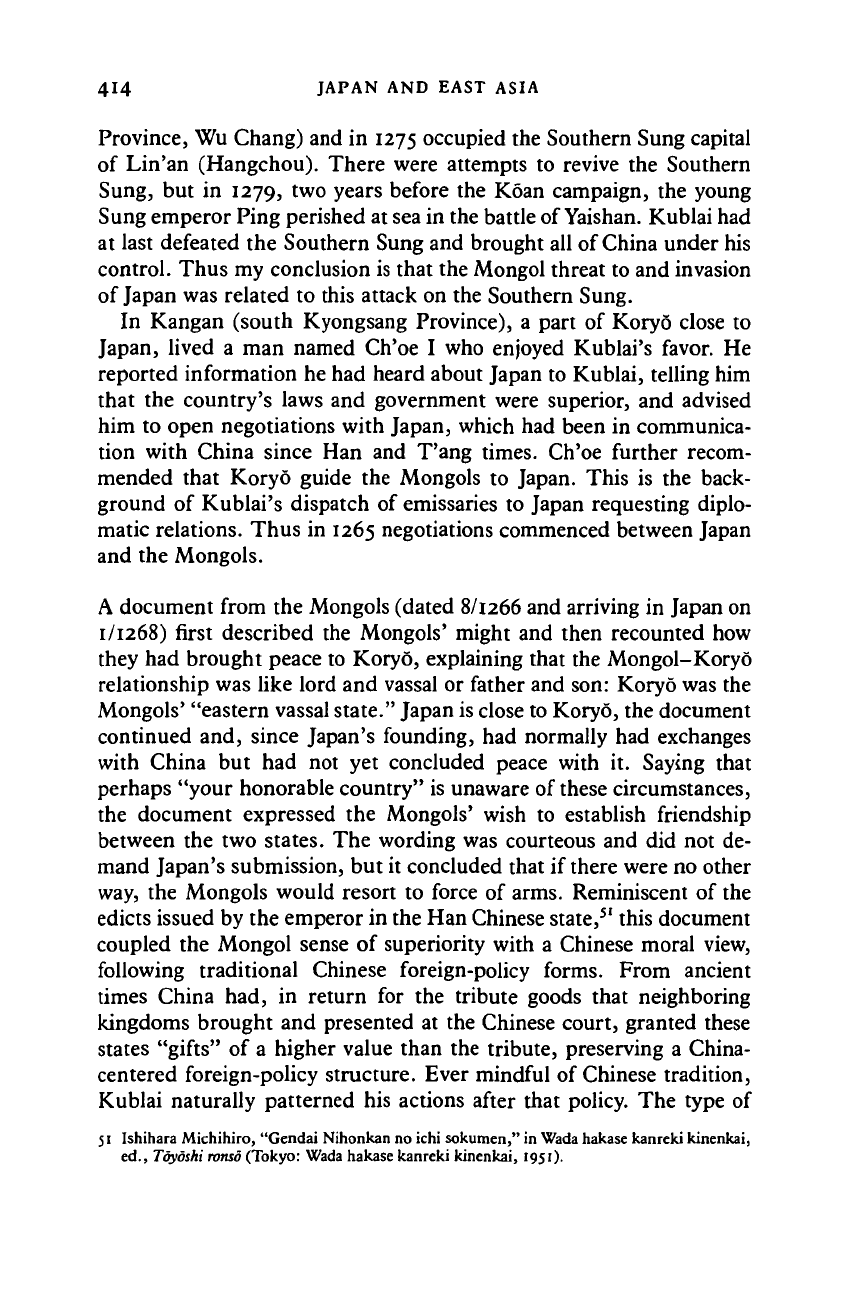
414 JAPAN AND EAST ASIA
Province, Wu Chang) and in 1275 occupied the Southern Sung capital
of Lin'an (Hangchou). There were attempts to revive the Southern
Sung, but in 1279, two years before the Koan campaign, the young
Sung emperor Ping perished at sea in the battle of Yaishan. Kublai had
at last defeated the Southern Sung and brought all of China under his
control. Thus my conclusion is that the Mongol threat to and invasion
of Japan was related to this attack on the Southern Sung.
In Kangan (south Kyongsang Province), a part of Koryo close to
Japan, lived a man named Ch'oe I who enjoyed Kublai's favor. He
reported information he had heard about Japan to Kublai, telling him
that the country's laws and government were superior, and advised
him to open negotiations with Japan, which had been in communica-
tion with China since Han and T'ang times. Ch'oe further recom-
mended that Koryo guide the Mongols to Japan. This is the back-
ground of Kublai's dispatch of emissaries to Japan requesting diplo-
matic relations. Thus in 1265 negotiations commenced between Japan
and the Mongols.
A document from the Mongols (dated 8/1266 and arriving in Japan on
1/1268)
first described the Mongols' might and then recounted how
they had brought peace to Koryo, explaining that the Mongol-Koryo
relationship was like lord and vassal or father and son: Koryo was the
Mongols' "eastern vassal state." Japan is close to Koryo, the document
continued and, since Japan's founding, had normally had exchanges
with China but had not yet concluded peace with it. Saying that
perhaps "your honorable country" is unaware of these circumstances,
the document expressed the Mongols' wish to establish friendship
between the two states. The wording was courteous and did not de-
mand Japan's submission, but it concluded that if there were no other
way, the Mongols would resort to force of arms. Reminiscent of the
edicts issued by the emperor in the Han Chinese state,
51
this document
coupled the Mongol sense of superiority with a Chinese moral view,
following traditional Chinese foreign-policy forms. From ancient
times China had, in return for the tribute goods that neighboring
kingdoms brought and presented at the Chinese court, granted these
states "gifts" of a higher value than the tribute, preserving a China-
centered foreign-policy structure. Ever mindful of Chinese tradition,
Kublai naturally patterned his actions after that policy. The type of
51 Ishihara Michihiro, "Gendai Nihonkan no ichi sokumen," in Wada hakase kanreki kinenkai,
ed.,
Toyoski
ronso
(Tokyo: Wada hakase kanreki kinenkai, 1951).
Cambridge Histories Online © Cambridge University Press, 2008
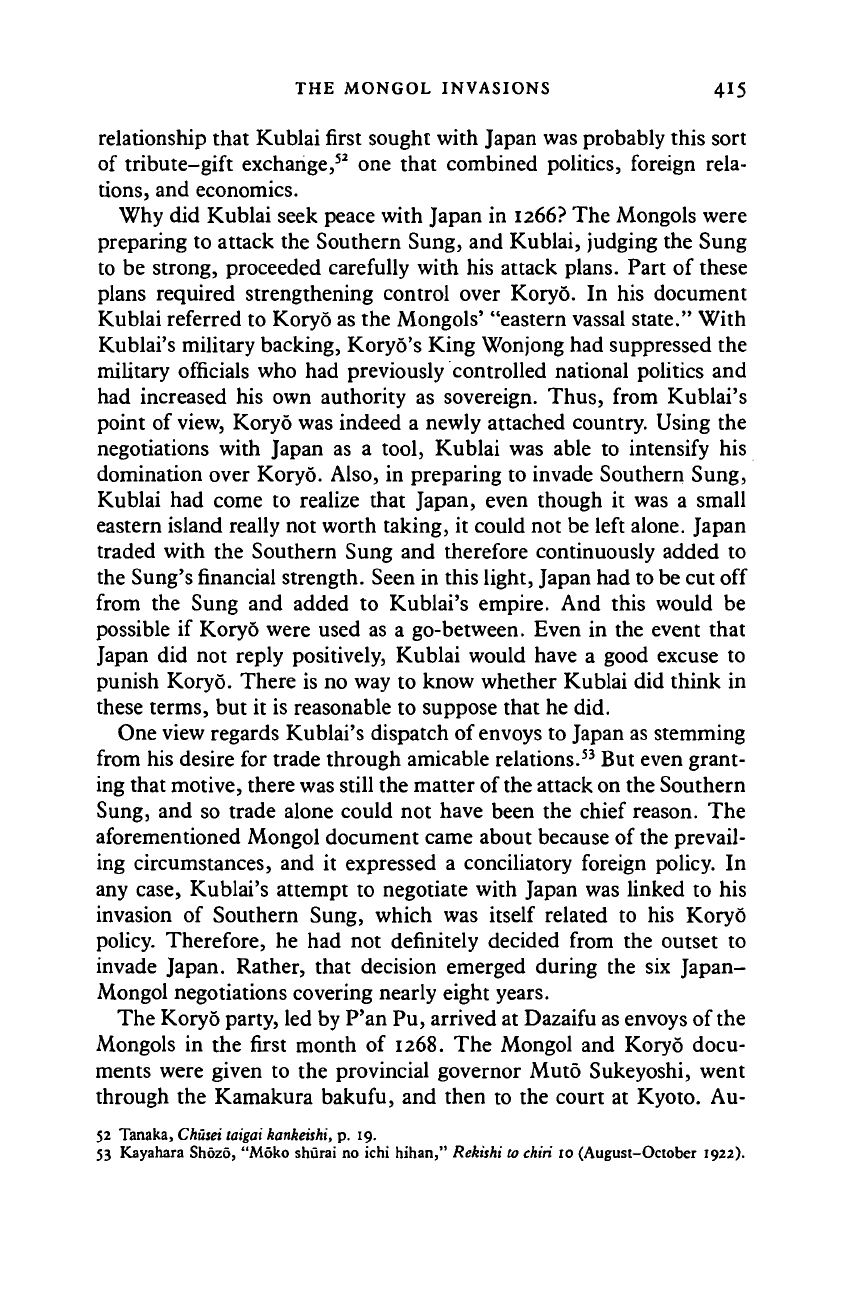
THE MONGOL INVASIONS 415
relationship that Kublai first sought with Japan was probably this sort
of tribute-gift exchange,
52
one that combined politics, foreign rela-
tions,
and economics.
Why did Kublai seek peace with Japan in 1266? The Mongols were
preparing to attack the Southern Sung, and Kublai, judging the Sung
to be strong, proceeded carefully with his attack plans. Part of these
plans required strengthening control over Koryo. In his document
Kublai referred to Koryo as the Mongols' "eastern vassal state." With
Kublai's military backing, Koryo's King Wonjong had suppressed the
military officials who had previously controlled national politics and
had increased his own authority as sovereign. Thus, from Kublai's
point of
view,
Koryo was indeed a newly attached country. Using the
negotiations with Japan as a tool, Kublai was able to intensify his
domination over Koryo. Also, in preparing to invade Southern Sung,
Kublai had come to realize that Japan, even though it was a small
eastern island really not worth taking, it could not be left alone. Japan
traded with the Southern Sung and therefore continuously added to
the Sung's
financial
strength. Seen in this light, Japan had to be cut off
from the Sung and added to Kublai's empire. And this would be
possible if Koryo were used as a go-between. Even in the event that
Japan did not reply positively, Kublai would have a good excuse to
punish Koryo. There is no way to know whether Kublai did think in
these terms, but it is reasonable to suppose that he did.
One view regards Kublai's dispatch of
envoys
to Japan as stemming
from his desire for trade through amicable relations.
53
But even grant-
ing that motive, there was still the matter of
the
attack on the Southern
Sung, and so trade alone could not have been the chief reason. The
aforementioned Mongol document came about because of the prevail-
ing circumstances, and it expressed a conciliatory foreign policy. In
any case, Kublai's attempt to negotiate with Japan was linked to his
invasion of Southern Sung, which was itself related to his Koryo
policy. Therefore, he had not definitely decided from the outset to
invade Japan. Rather, that decision emerged during the six Japan-
Mongol negotiations covering nearly eight years.
The Koryo party, led by P'an Pu, arrived at Dazaifu as envoys of the
Mongols in the first month of 1268. The Mongol and Koryo docu-
ments were given to the provincial governor Muto Sukeyoshi, went
through the Kamakura bakufu, and then to the court at Kyoto. Au-
52 Tanaka, Chusei taigai
kankeishi,
p. 19.
53 Kayahara Shozo, "Moko shurai no ichi hihan," Rekishi to chiri 10 (August-October 1922).
Cambridge Histories Online © Cambridge University Press, 2008
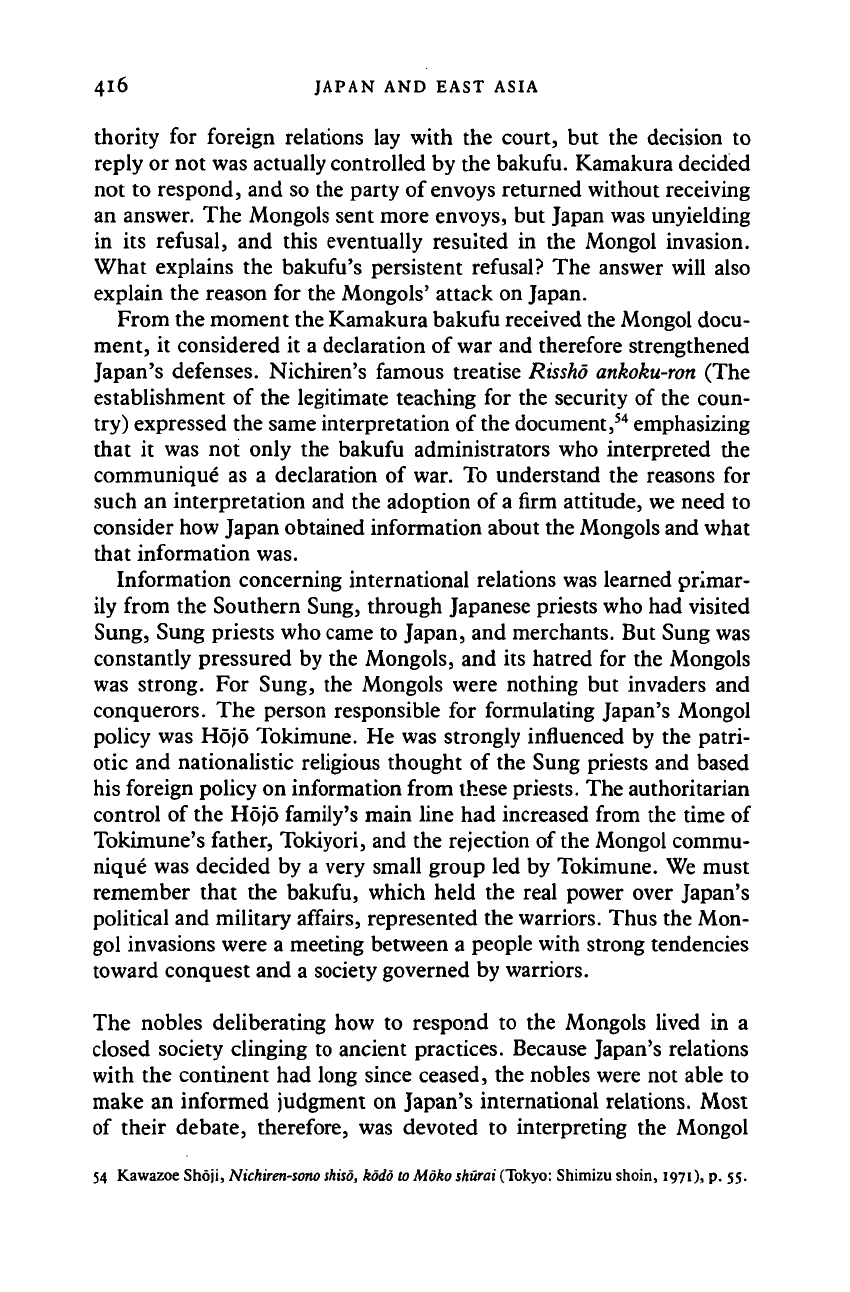
4l6 JAPAN AND EAST ASIA
thority
for
foreign relations
lay
with
the
court,
but the
decision
to
reply or not was actually controlled by the bakufu. Kamakura decided
not
to
respond, and so the party of
envoys
returned without receiving
an answer. The Mongols sent more envoys, but Japan was unyielding
in
its
refusal,
and
this eventually resulted
in the
Mongol invasion.
What explains
the
bakufu's persistent refusal?
The
answer will also
explain the reason
for
the Mongols' attack on Japan.
From the moment the Kamakura bakufu received the Mongol docu-
ment,
it
considered
it
a declaration
of
war and therefore strengthened
Japan's defenses. Nichiren's famous treatise
Rissho ankoku-ron
(The
establishment
of
the legitimate teaching
for
the security
of
the coun-
try) expressed the same interpretation
of
the document,
54
emphasizing
that
it was not
only
the
bakufu administrators who interpreted
the
communique
as a
declaration
of
war.
To
understand
the
reasons
for
such
an
interpretation and the adoption
of
a
firm attitude, we need
to
consider how Japan obtained information about the Mongols and what
that information was.
Information concerning international relations was learned primar-
ily from the Southern Sung, through Japanese priests who had visited
Sung, Sung priests who came to Japan, and merchants. But Sung was
constantly pressured by the Mongols,
and its
hatred
for
the Mongols
was strong.
For
Sung,
the
Mongols were nothing
but
invaders
and
conquerors.
The
person responsible
for
formulating Japan's Mongol
policy was Hojo Tokimune.
He
was strongly influenced
by the
patri-
otic
and
nationalistic religious thought
of
the Sung priests and based
his foreign policy on information from these priests. The authoritarian
control
of
the Hojo family's main line had increased from the time of
Tokimune's father, Tokiyori, and the rejection of the Mongol commu-
nique was decided
by a
very small group led by Tokimune. We must
remember that
the
bakufu, which held
the
real power over Japan's
political and military affairs, represented the warriors. Thus the Mon-
gol invasions were
a
meeting between
a
people with strong tendencies
toward conquest and
a
society governed by warriors.
The nobles deliberating
how to
respond
to the
Mongols lived
in a
closed society clinging
to
ancient practices. Because Japan's relations
with the continent had long since ceased, the nobles were not able
to
make
an
informed judgment
on
Japan's international relations. Most
of their debate, therefore,
was
devoted
to
interpreting
the
Mongol
54 Kawazoe Shoji, Nichiren-sono
shiso,
kodo to Moko shurai (Tokyo: Shimizu shoin, 1971),
p. 55.
Cambridge Histories Online © Cambridge University Press, 2008
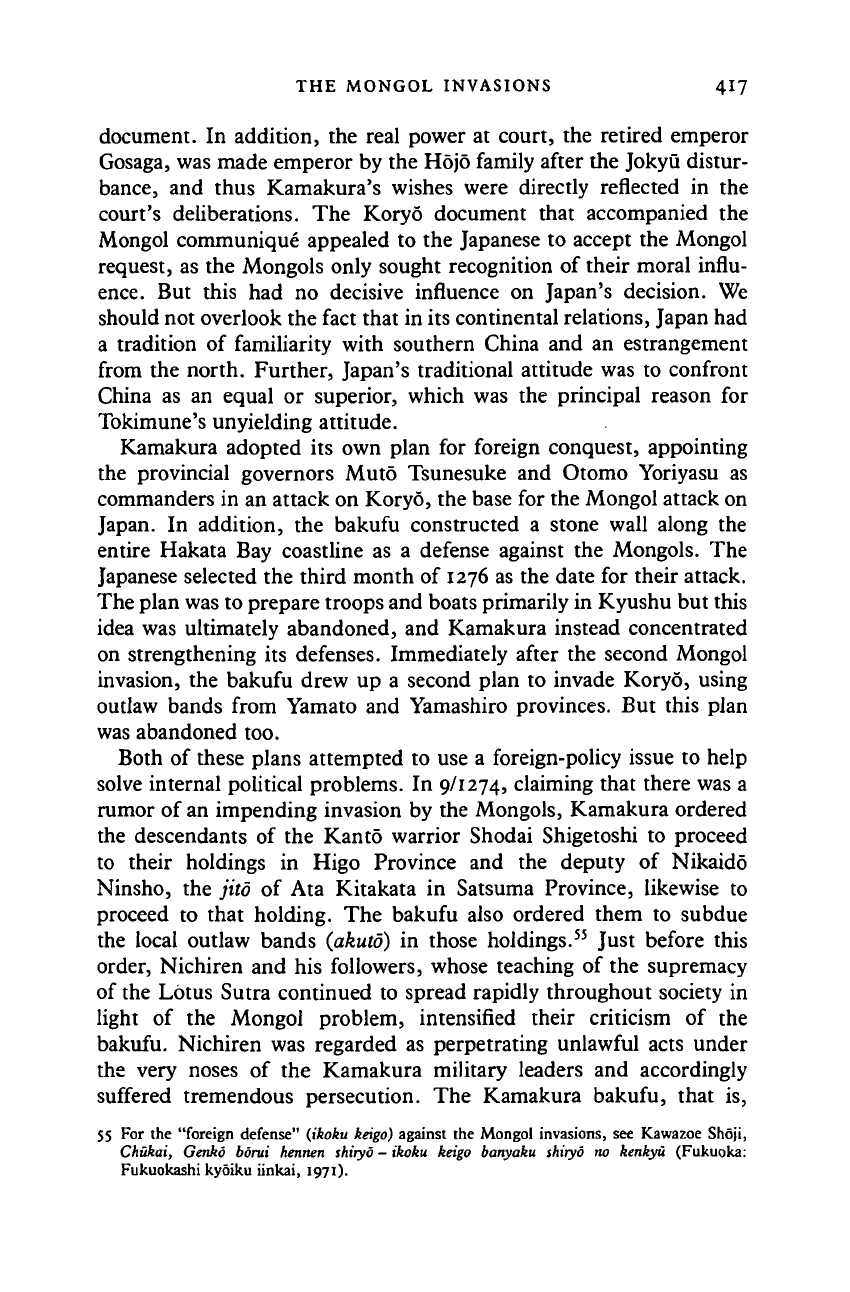
THE MONGOL INVASIONS 417
document. In addition, the real power at court, the retired emperor
Gosaga, was made emperor by the Hojo family after the Jokyu distur-
bance, and thus Kamakura's wishes were directly reflected in the
court's deliberations. The Koryo document that accompanied the
Mongol communique appealed to the Japanese to accept the Mongol
request, as the Mongols only sought recognition of their moral influ-
ence.
But this had no decisive influence on Japan's decision. We
should not overlook the fact that in its continental relations, Japan had
a tradition of familiarity with southern China and an estrangement
from the north. Further, Japan's traditional attitude was to confront
China as an equal or superior, which was the principal reason for
Tokimune's unyielding attitude.
Kamakura adopted its own plan for foreign conquest, appointing
the provincial governors Muto Tsunesuke and Otomo Yoriyasu as
commanders in an attack on Koryo, the base for the Mongol attack on
Japan. In addition, the bakufu constructed a stone wall along the
entire Hakata Bay coastline as a defense against the Mongols. The
Japanese selected the third month of 1276 as the date for their attack.
The plan was to prepare troops and boats primarily in Kyushu but this
idea was ultimately abandoned, and Kamakura instead concentrated
on strengthening its defenses. Immediately after the second Mongol
invasion, the bakufu drew up a second plan to invade Koryo, using
outlaw bands from Yamato and Yamashiro provinces. But this plan
was abandoned too.
Both of these plans attempted to use a foreign-policy issue to help
solve internal political problems. In 9/1274, claiming that there was a
rumor of an impending invasion by the Mongols, Kamakura ordered
the descendants of the Kanto warrior Shodai Shigetoshi to proceed
to their holdings in Higo Province and the deputy of Nikaido
Ninsho, the jito of Ata Kitakata in Satsuma Province, likewise to
proceed to that holding. The bakufu also ordered them to subdue
the local outlaw bands (akuto) in those holdings.
55
Just before this
order, Nichiren and his followers, whose teaching of the supremacy
of the Lotus Sutra continued to spread rapidly throughout society in
light of the Mongol problem, intensified their criticism of the
bakufu. Nichiren was regarded as perpetrating unlawful acts under
the very noses of the Kamakura military leaders and accordingly
suffered tremendous persecution. The Kamakura bakufu, that is,
55 For the "foreign defense" (ikoku keigo) against the Mongol invasions, see Kawazoe Shoji,
Chukai, Genko borui hennen shiryo
—
ikoku keigo banyaku shiryo no kenkyu (Fukuoka:
Fukuokashi kyoiku iinkai, 1971).
Cambridge Histories Online © Cambridge University Press, 2008
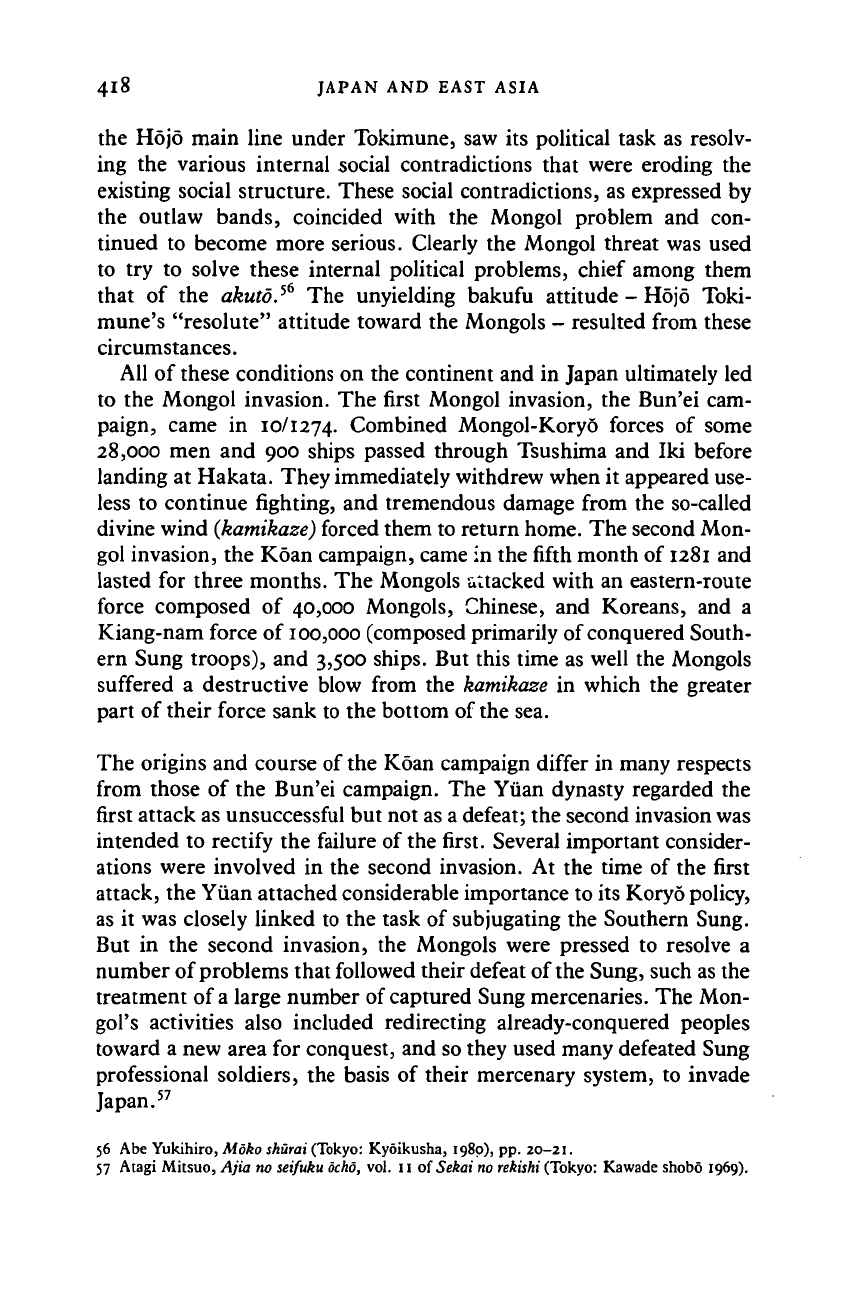
418 JAPAN AND EAST ASIA
the Hojo main line under Tokimune, saw its political task as resolv-
ing the various internal social contradictions that were eroding the
existing social structure. These social contradictions, as expressed by
the outlaw bands, coincided with the Mongol problem and con-
tinued to become more serious. Clearly the Mongol threat was used
to try to solve these internal political problems, chief among them
that of the akuto.
56
The unyielding bakufu attitude - Hojo Toki-
mune's "resolute" attitude toward the Mongols - resulted from these
circumstances.
All of these conditions on the continent and in Japan ultimately led
to the Mongol invasion. The first Mongol invasion, the Bun'ei cam-
paign, came in 10/1274. Combined Mongol-Koryo forces of some
28,000 men and 900 ships passed through Tsushima and Iki before
landing at Hakata. They immediately withdrew when it appeared use-
less to continue fighting, and tremendous damage from the so-called
divine wind
(kamikaze)
forced them to return home. The second Mon-
gol invasion, the Koan campaign, came in the fifth month of
1281
and
lasted for three months. The Mongols attacked with an eastern-route
force composed of 40,000 Mongols, Chinese, and Koreans, and a
Kiang-nam force of 100,000 (composed primarily of conquered South-
ern Sung troops), and 3,500 ships. But this time as well the Mongols
suffered a destructive blow from the kamikaze in which the greater
part of their force sank to the bottom of the sea.
The origins and course of the Koan campaign differ in many respects
from those of the Bun'ei campaign. The Yuan dynasty regarded the
first attack as unsuccessful but not as a defeat; the second invasion was
intended to rectify the failure of the first. Several important consider-
ations were involved in the second invasion. At the time of the first
attack, the Yuan attached considerable importance to its Koryo policy,
as it was closely linked to the task of subjugating the Southern Sung.
But in the second invasion, the Mongols were pressed to resolve a
number of problems that followed their defeat of
the
Sung, such as the
treatment of
a
large number of captured Sung mercenaries. The Mon-
gol's activities also included redirecting already-conquered peoples
toward a new area for conquest, and so they used many defeated Sung
professional soldiers, the basis of their mercenary system, to invade
Japan.
57
56 Abe Yukihiro, Moko shurai (Tokyo: Kyoikusha, 1980), pp.
20-21.
57 Atagi Mitsuo, Ajia no seifuku
ocho,
vol. 11 of Sekai no rekishi (Tokyo: Kawade shobo 1969).
Cambridge Histories Online © Cambridge University Press, 2008
